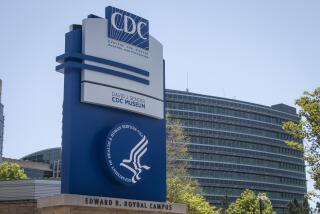State may OK funds for testing beaches
- Share via
After Gov. Arnold Schwarzenegger slashed the $1 million spent each year on ocean water testing, county health officials scrambled to piece together new plans to protect beachgoers from harmful bacteria.
The cut devastated some of the water quality monitoring programs in 17 counties along California’s coast and the San Francisco Bay, forcing them to find alternative funds or quit monitoring the surf.
But a temporary infusion of cash from the state water agency could restore seawater sampling, at least for the time being.
At the governor’s request, the State Water Resources Control Board is scheduled to vote today on whether to distribute about $2 million to coastal counties over the next two fiscal years to keep the water quality program alive.
The $984,000 earmarked to help these counties pay for regular beach monitoring in the busy season between April and October was cut in a line-item veto by Schwarzenegger last month. Local environmental health officials say the program, signed into law in 1997, has helped identify sources of fecal contamination, reduced dangerous bacteria levels and kept the public informed on when to stay out of the water because of unhealthy bacteria levels.
“The public really, really likes this program,” said Larry Honeybourne, program manager with the environmental division of the Orange County Health Care Agency. Orange County receives about $208,000 a year from the state for water quality monitoring.
San Diego County was one of the hardest hit by the veto, losing $302,000, which wiped out its dry season water quality program. Without the state funding, the program shut down for the final weeks of October, ending warnings about polluted beaches and daily e-mail and podcast water quality updates.
Coastal officials “were caught by surprise that the governor blue-penciled it out,” said San Diego County Board of Supervisors Chairman Greg Cox. He wrote letters and encouraged local officials to press for restoration of the program, which keeps tabs on 55 San Diego County shoreline locations during the summer months.
“We have an obligation to our own residents and to the people who come to San Diego to guarantee that our beaches are safe to use,” said Cox, who plans to testify before the state water board today.
Analysis of water samples collected from 86 locations in Los Angeles County can continue year-round without state grants, said Eric Edwards, chief environmental health specialist with the Los Angeles County Department of Public Health’s water quality program.
State officials describe California’s water quality monitoring as the most rigorous in the nation.
Environmental groups condemned the elimination of the funding, arguing that it put beachgoers at risk. Heal the Bay and other organizations have lobbied the governor and state agencies to restore the funds.
Although the water board’s vote could offer a short-term solution to keep the surf safe for beachgoers, environmental advocates are still concerned about the program’s long-term prospects.
Monitoring the ocean “is really necessary for public health,” said Kirsten James, Heal the Bay’s water quality director. “We don’t want to see any gaps in public funding.”
If state water officials approve the resolution, about $1 million this fiscal year and $1 million the next would come from Proposition 13 bond funds designated for water quality projects, said William L. Rukeyser, State Water Resources Control Board spokesman. Testing is vital, he said, “because it either validates that the actions that we’ve taken are paying off or it acts as . . . an early warning.”
The board has distributed about $100 million in grants for projects to help clean the coast, such as netting to keep birds -- and bird droppings -- off Baby Beach in Orange County.
The cut, one of $510 million worth of programs deleted from the $145-billion state budget, “was in no way any statement about this program not being worthwhile or important,” said H.D. Palmer, a deputy director in the state Department of Finance. Rather, the governor was laboring to build up state budget reserves and gird for the cost of fighting wildfires, he said.
--
susannah.rosenblatt@latimes.com
More to Read
Sign up for Essential California
The most important California stories and recommendations in your inbox every morning.
You may occasionally receive promotional content from the Los Angeles Times.













